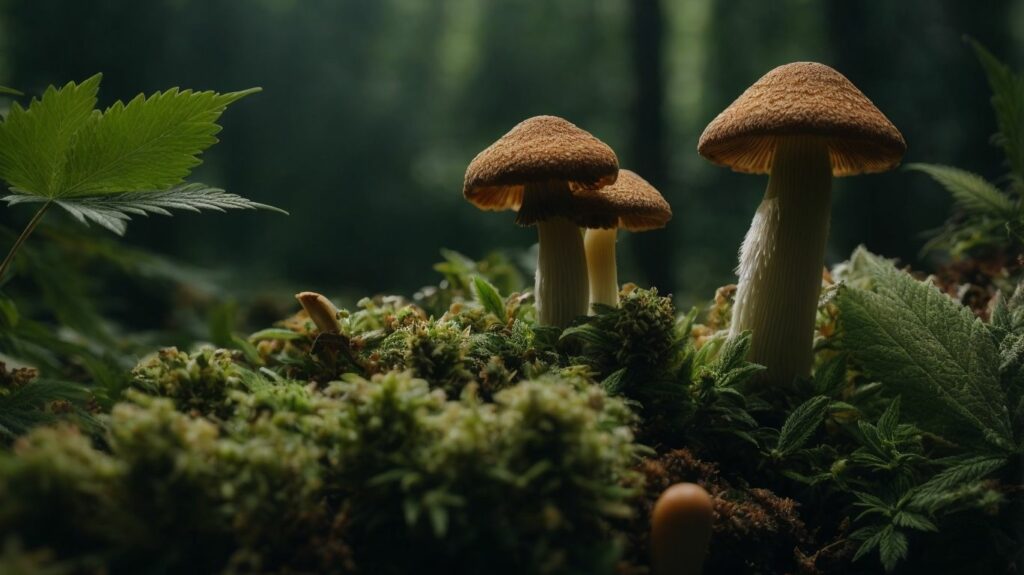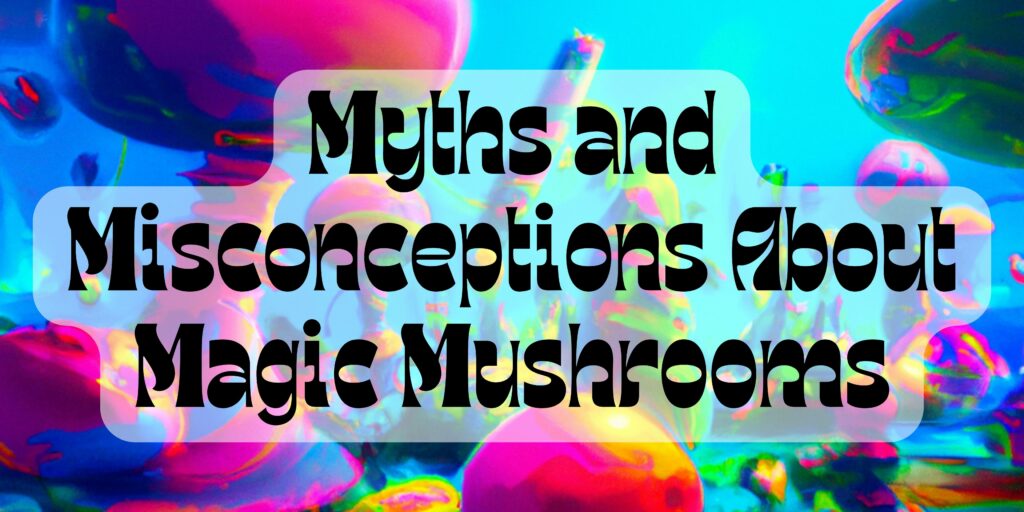Are you curious about the effects of shrooms and weed? In today’s world, marijuana and psychedelic mushrooms are gaining popularity. But with their increased use, concerns about their potential effects and safety have also arisen. In this article, we will delve into the key differences between shrooms and weed, and address any concerns you may have about using them.
What Are Shrooms and Weed?
Shrooms and Weed are two substances that can have psychoactive effects on the body and mind. Shrooms, also known as magic mushrooms, contain a compound called psilocybin, which can cause hallucinations and altered perceptions. On the other hand, Weed, or marijuana, contains THC, which can induce relaxation and feelings of euphoria. While both substances may alter the mind, it is important to understand that they have distinct chemical compositions and effects. It is always recommended to conduct thorough research and seek professional advice before trying any substance that may carry potential risks or side effects.
What Are the Effects of Shrooms and Weed?
Shrooms and weed are two popular substances that are often used for recreational or medicinal purposes. While both have psychoactive properties, they differ greatly in their effects on the mind and body. In this section, we will explore the distinct physical and mental effects of shrooms and weed. From sensory changes to altered perceptions, we’ll delve into the unique experiences that each substance can induce. So, let’s take a closer look at the effects of shrooms and weed and how they differ from each other.
1. Physical Effects
The physical effects of consuming shrooms or weed can vary from person to person, but there are some common experiences to be aware of:
- Changes in perception, such as an altered sense of time, colors, and sounds
- Relaxed muscles and decreased coordination
- Increased heart rate and blood pressure
- Dry mouth and increased thirst
- Red or bloodshot eyes
- Appetite changes, including increased hunger
A true
The use of mind-altering substances dates back thousands of years, with ancient cultures utilizing plants like cannabis and mushrooms for spiritual and medicinal purposes. These substances have been part of human culture and rituals, shaping our understanding of their effects on the mind and body.
2. Mental Effects
Mental effects are a significant aspect of consuming shrooms and weed. Here are the effects to be aware of:
- Altered perception: Both substances can distort sensory perception, leading to changes in how one perceives the world.
- Mood changes: Both shrooms and weed can influence mood, causing feelings of euphoria, relaxation, or anxiety.
- Enhanced creativity: Some users report increased creativity and imagination while under the influence of shrooms or weed.
- Cognitive impairment: Both substances can impair memory, attention, and cognitive function, affecting decision-making abilities.
- Psychological experiences: Intense emotional and introspective experiences, such as profound insights or spiritual awakenings, can occur with both shrooms and weed.
Shrooms and weed may have some similarities, but let’s not compare apples and oranges – unless you’re tripping.
What Are the Differences Between Shrooms and Weed?
Shrooms and weed are two commonly used psychoactive substances, but they have significant differences. In this section, we will explore the distinctions between these two substances, including their chemical composition, legal status, origin, and consumption methods. By understanding these differences, we can gain a better understanding of how these substances affect the body and mind, and make informed decisions about their use.
1. Chemical Composition
The chemical composition of shrooms and weed plays a significant role in their effects on the body and mind. Here are the key factors to consider:
- Active Compounds: Shrooms contain psilocybin, which is converted to psilocin in the body. Weed contains THC, CBD, and other cannabinoids.
- Effects on Receptors: Psilocin interacts with serotonin receptors, affecting mood, perception, and cognition. THC binds to cannabinoid receptors, impacting memory, appetite, and pain.
- Dosage: The potency of shrooms depends on the species and growing conditions. The strength of weed varies based on the strain and cultivation techniques.
- Duration of Effects: The effects of shrooms can last 4-6 hours, while weed effects typically last 2-3 hours.
True story: A friend tried shrooms for the first time and experienced profound introspection and a sense of connectedness with nature. They found the chemical composition fascinating and wanted to learn more about the differences between shrooms and weed.
2. Legal Status
The legal status of shrooms and weed varies depending on the country and jurisdiction. Here are some steps to consider when understanding the legal status of these substances:
- Research local laws: Familiarize yourself with the specific laws and regulations regarding shrooms and weed in your area.
- Consult legal sources: Seek information from official government websites, law enforcement agencies, or legal experts to understand the legal status in your jurisdiction.
- Consider medical use: Some countries allow the medical use of marijuana or psychedelics under certain circumstances. Research if these substances are permitted for medicinal purposes.
- Understand penalties: Be aware of the potential legal consequences, such as fines or imprisonment, associated with the possession, sale, or cultivation of shrooms and weed.
- Stay updated: Laws regarding shrooms and weed may change over time. Regularly check for updates to ensure you have the most current information.
They may have different origins, but both shrooms and weed have been responsible for some pretty wild trips and questionable life choices.
3. Origin
The origin of shrooms and weed can provide insight into their cultural significance and historical use. Here are a few key points regarding their origin:
- Shrooms:
- Shrooms, or magic mushrooms, have been used for centuries in various cultures, including indigenous communities in South America, Africa, and Asia.
- Psilocybin-containing mushrooms have been traditionally used for spiritual and healing purposes, often in religious ceremonies or shamanic rituals.
- These mushrooms can be found in different regions worldwide, with specific species growing in specific climates and environments.
- Weed:
- Weed, or cannabis, has been cultivated and used for thousands of years, with origins traced back to ancient civilizations such as China, India, and Egypt.
- Cannabis has been used for medicinal, spiritual, and recreational purposes throughout history.
- It is believed that cannabis originated in Central Asia and eventually spread to different parts of the world.
Understanding the origin of shrooms and weed can provide a deeper appreciation for their cultural significance and historical context. It is important to research and respect the cultural traditions and legal regulations surrounding their use.
Remember, always prioritize safety and legality when considering the use of shrooms or weed. Consult with professionals and adhere to local laws and regulations.
4. Consumption Methods
When consuming shrooms or weed, there are various methods available. Here are some common ways to consume:
- Smoking: For weed, smoking is the most popular method. It can be done using a joint, pipe, or bong.
- Vaporizing: Vaporizers heat the substance without combustion, producing a vapor that can be inhaled.
- Eating: Shrooms can be consumed by incorporating them into food or making them into a tea. Weed can be infused into edibles.
- Tinctures: These are liquid extracts that can be taken orally or mixed into beverages.
Pro Tip: Start with a small dose and wait for the effects to kick in before trying other consumption methods.
What Are the Similarities Between Shrooms and Weed?
While shrooms and weed may seem like vastly different substances, they actually share several similarities. In this section, we will explore the commonalities between these two psychedelics, including their psychoactive properties and potential for misuse and addiction. Additionally, we will also discuss how both shrooms and weed have been used for medicinal purposes, providing potential benefits for certain health conditions. Keep reading to learn more about the surprising similarities between these two substances.
1. Psychoactive Properties
The psychoactive properties of shrooms and weed result in altered perceptions, thoughts, and feelings. Here are the steps to understand their psychoactive effects:
- Activation: Both substances interact with specific receptors in the brain, triggering psychoactive effects.
- Chemical reactions: Psilocybin in shrooms converts to psilocin, affecting serotonin receptors. THC in weed binds to cannabinoid receptors.
- Effects: Shrooms produce hallucinations, intensified emotions, and altered sense of time. Weed can induce euphoria, relaxation, altered perception, and increased appetite.
- Duration: The effects of shrooms can last 4-6 hours, while weed effects typically last 2-4 hours.
Fun Fact: Shrooms have been used for centuries in spiritual and religious rituals.
2. Potential for Misuse and Addiction
The potential for misuse and addiction is a significant concern with both shrooms and weed. While shrooms are not considered physically addictive, they can be habit-forming, leading to psychological dependence. Weed, on the other hand, can be both psychologically and physically addictive, with withdrawal symptoms upon cessation. Both substances have the potential for misuse, especially when used as a coping mechanism or in excessive amounts. It is important to use shrooms and weed responsibly and be aware of the potential risks associated with their misuse and addiction.
In 1970, the Controlled Substances Act categorized hallucinogenic mushrooms (containing psilocybin) as a Schedule I substance due to concerns about their potential for abuse and lack of accepted medical use. The same act classified marijuana (containing THC) as a Schedule I substance, indicating its high potential for misuse and addiction based on available evidence at the time. These classifications have influenced the legal and societal perspectives towards both substances in the United States.
Who needs a prescription when you have shrooms and weed for all your medicinal needs? Just kidding, please consult a doctor.
3. Medicinal Uses
Both shrooms and weed have potential medicinal uses, although more research is needed to fully understand their benefits.
- Possible Medicinal Uses of Shrooms:
- Psilocybin, found in shrooms, has shown promise in treating mental health conditions like depression, anxiety, and PTSD.
- Studies indicate that psilocybin may also have potential in helping with addiction, such as smoking cessation.
- Research suggests that shrooms may also be beneficial in reducing end-of-life anxiety in cancer patients.
- Possible Medicinal Uses of Weed:
- Medical marijuana has been used to alleviate chronic pain in conditions like arthritis and multiple sclerosis.
- THC and CBD, compounds found in weed, have been studied for their potential in managing nausea and vomiting in cancer patients undergoing chemotherapy.
- Research suggests that cannabinoids may have anti-inflammatory properties and could potentially be helpful in treating conditions like Crohn’s disease.
It’s important to note that the medicinal uses of shrooms and weed are still being explored, and it’s crucial to consult with a healthcare professional before considering any alternative treatments.
Which is Safer: Shrooms or Weed?
When comparing the safety of shrooms and weed, it’s essential to take into account various factors. Firstly, shrooms have a higher risk of causing hallucinations and a bad trip compared to weed. However, weed can negatively impact cognitive function and memory, particularly for young users. Additionally, the method of consumption also plays a role, as smoking weed can pose respiratory risks. Ultimately, it’s vital to prioritize responsible use and consider individual health conditions and preferences. Consulting with a healthcare professional is advised to make an informed decision.
Can Shrooms and Weed Be Used Together?
Is it Safe to Combine Shrooms and Weed?
Using shrooms and weed together is a personal choice, but it’s important to consider the potential risks and effects. Both substances can enhance each other’s psychoactive properties, leading to more intense experiences. However, combining them can also increase the chances of experiencing anxiety, paranoia, or other negative side effects. It’s crucial to start with low doses of each substance and be in a safe and comfortable environment. If you have any underlying health conditions or are on medication, it’s best to consult with a healthcare professional before combining shrooms and weed.
In indigenous cultures, the traditional use of shrooms and weed together has been documented for centuries, particularly in spiritual and medicinal practices. These substances were often used in rituals to achieve altered states of consciousness and gain insights. However, it’s essential to respect and understand the cultural and historical context when exploring the combination of shrooms and weed.
What Are the Potential Risks of Combining Shrooms and Weed?
The combination of shrooms and weed has become a popular choice among recreational drug users, but what are the potential risks of this combination? In this section, we will explore the various risks associated with combining these two substances, including the increased intensity of effects, unknown interactions, and potential legal implications. By understanding the potential risks, individuals can make informed decisions when it comes to consuming shrooms and weed together.
1. Increased Intensity of Effects
- When combining shrooms and weed, it’s important to be aware that it can lead to an increased intensity of effects. Here are some steps to consider:
- Start with low doses: Begin with small amounts of both substances to gauge how they interact with each other.
- Understand individual tolerance: Recognize that everyone’s tolerance varies, so what works for one person may not work for another.
- Know the effects: Be aware that combining shrooms and weed can potentially intensify hallucinations, euphoria, and altered perception.
- Be in a safe environment: Ensure you are in a comfortable and familiar setting with trusted individuals to minimize any potential risks.
- Stay hydrated and nourished: Remember to drink water and have a light meal before consuming to support your body during the experience.
These steps can help you navigate the increased intensity of effects when combining shrooms and weed.
2. Unknown Interactions
When combining shrooms and weed, there are several unknown interactions that can occur. It is important to be cautious and mindful of potential risks. Here are some steps to consider:
- Start with low doses: Begin with small amounts of both substances to gauge their individual effects and how they interact.
- Know your tolerance: Understand your tolerance for each substance separately before combining them, especially since there may be unknown interactions.
- Be aware of intensified effects: The combination may amplify the effects of both substances, leading to a more intense experience.
- Monitor your mindset: Pay attention to your mental state and mood, as the combination may affect your thoughts and emotions differently.
- Stay in a safe environment: Ensure you are in a comfortable and familiar setting with trusted individuals around.
Remember, everyone reacts differently, and the interaction between shrooms and weed can vary. It is always best to err on the side of caution and seek guidance from a healthcare professional if needed.
3. Legal Implications
When it comes to the legal implications of using shrooms and weed, it’s important to be aware of the laws and regulations in your jurisdiction. Here are some steps to consider:
- Research: Familiarize yourself with the laws regarding shrooms and weed in your area.
- Consult: Seek legal advice or consult local authorities to understand the specific legal implications.
- Penalties: Be aware of the potential consequences, such as fines, imprisonment, or other legal actions, related to the use of shrooms and weed.
- Medical Use: Understand any exceptions or allowances for medical use, if applicable.
- Responsible Use: Adhere to legal guidelines and regulations to avoid any legal issues related to the use of shrooms and weed.
Frequently Asked Questions
What are the differences between shrooms and weed?
Shrooms and weed are both psychoactive substances, but they differ in terms of their effects and origin. Shrooms, also known as magic mushrooms, are hallucinogens that come from specific types of mushrooms. On the other hand, weed, also known as marijuana, is derived from the cannabis plant and is often used for its relaxing and euphoric effects.
Which one has stronger effects: shrooms or weed?
The strength of the effects of shrooms and weed can vary depending on the individual and the dosage. However, shrooms are generally considered to have more intense and longer-lasting effects compared to weed.
Can shrooms and weed be used together?
It is not recommended to use shrooms and weed together. Combining different psychoactive substances can increase the risk of negative reactions and may lead to a more intense and potentially overwhelming experience.
Which one has a higher potential for addiction: shrooms or weed?
Neither shrooms nor weed have a high potential for addiction. However, weed may have a slightly higher risk of developing a dependence or addiction due to its psychoactive effects and the potential for developing a habit.
Are shrooms or weed legal?
The legality of shrooms and weed varies depending on the country and state. In some places, both substances may be illegal, while in others, weed may be legal for medicinal or recreational use. It is important to research and understand the laws and regulations in your area before using either substance.
What are the potential risks and side effects of using shrooms and weed?
Shrooms and weed can both have various potential risks and side effects. Some common risks and side effects of shrooms may include nausea, anxiety, and a distorted sense of reality. Weed may cause dizziness, increased heart rate, and impaired cognitive function. It is always important to use these substances responsibly and in a safe environment.




